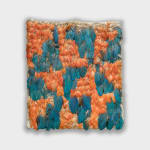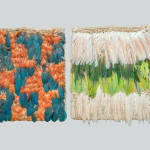Nazca Culture 100 BC-800 AD
Nazca Miniature Geometric Feather Coca Bag, Circa. 500 AD
Cotton with applied feathers
28 x 25 cm (inc. plexi frame)
11 x 9,8 in (inc. plexi frame)
11 x 9,8 in (inc. plexi frame)
NAZ0009
Copyright of Paul Hughes Fine Arts
Further images
The tradition of chewing coca leaves in Peru dates back over 8,000 years. High-ranking individuals carried the leaves in finely crafted bags, such as the one described here. This particular...
The tradition of chewing coca leaves in Peru dates back over 8,000 years. High-ranking individuals carried the leaves in finely crafted bags, such as the one described here. This particular coca bag, made of feathers, reflects the longstanding Andean tradition of using feathers for both personal adornment and environmental decoration. Feathers have been valued across the Andes for their universal appeal and striking beauty, but beyond aesthetics, they hold deep cultural significance. Among traditional societies, feathers and feather-adorned objects are believed to possess spiritual energy and supernatural power. The construction of this coca bag indicates interaction between coastal and highland regions, as the materials used—such as camelid fibre—originate from higher altitudes.
When combined with quicklime or ash, chewing coca leaves releases cocaine hydrochloride, which rapidly enters the bloodstream and induces a mild narcotic effect. The substance is believed to enhance energy and suppress hunger. In contemporary traditional societies, coca leaf chewing remains an integral part of social and religious customs, making it likely that similar practices existed thousands of years ago.
When combined with quicklime or ash, chewing coca leaves releases cocaine hydrochloride, which rapidly enters the bloodstream and induces a mild narcotic effect. The substance is believed to enhance energy and suppress hunger. In contemporary traditional societies, coca leaf chewing remains an integral part of social and religious customs, making it likely that similar practices existed thousands of years ago.
Exhibitions
Paul Kasmin, New york 1995Join our mailing list
* denotes required fields
We will process the personal data you have supplied in accordance with our privacy policy (available on request). You can unsubscribe or change your preferences at any time by clicking the link in our emails.







